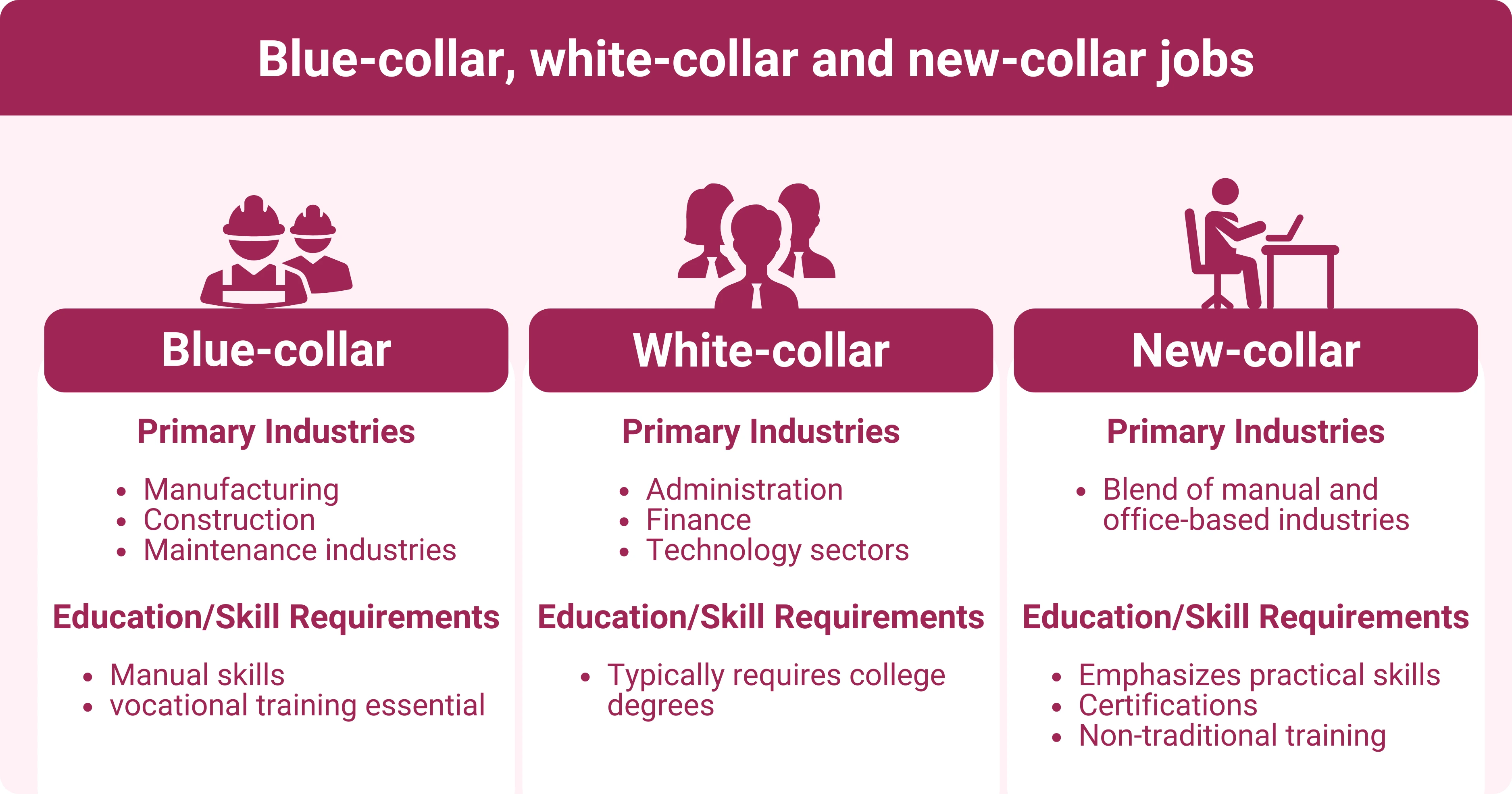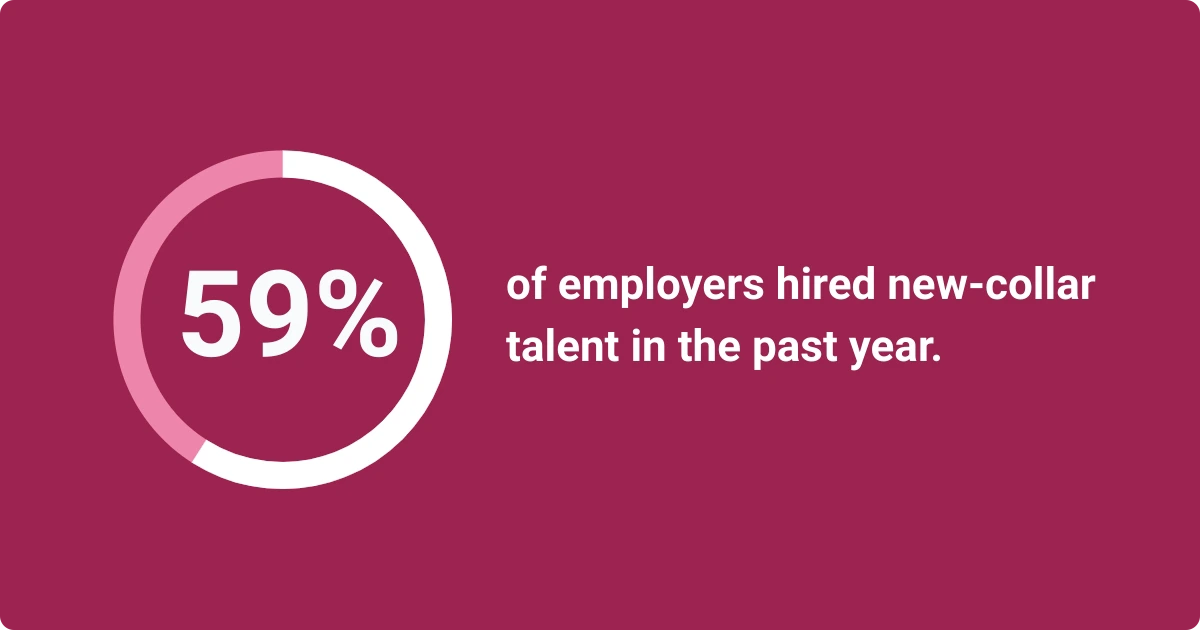New-Collar Jobs: The New Upskilling Revolution in the Workforce

There's a new role in town: the new-collar job.
This role bridges the gap between being a college graduate and a white-collar employee, relying on skills and practical experience rather than educational background as qualifications.
According to Employment in the IT Industry – Statistics & FactsOpens in a new tab by Statista, this shift is welcome news for the hiring industry, especially since 54% of global tech companies report a shortage of skilled workers.
More than that, it's already an undeniable trend. The Bureau of Labor Statistics predicts that between 2020 and 2030, 60% of new jobsOpens in a new tab will be new-collar occupations that won’t require any type of college degree.
And the talent pool seems to embrace the change, too, with 41% of U.S. adults reporting that they would get a certificateOpens in a new tab that would instantly qualify them for an in-demand job over a college degree.
It's a logical leap. The world of work is rapidly evolving in the tech golden age and the advent of artificial intelligence. Twelve-week boot camps and training programs can adapt to this much faster than a four-year degree program can. College is increasingly unaffordable.
Thus: everyone has to adapt, hiring methods included.
Here's everything you need to know about new-collar jobs and how to integrate them into your workforce.
Defining new-collar jobs
“New collar jobs” is a term coined by IBM’s former CEO, Ginni RomettyOpens in a new tab. It refers to roles that don’t require a traditional college degree but instead rely on honed technical skills acquired through training such as vocational schooling, hands-on experience, or coding boot camps.
Many new-collar workers are self-taught, developing their skills through certification programs, internships or apprenticeships, on-the-job experience, or community college.
They are considered "new" collar due to the industries and roles their skill sets match, like data science, cybersecurity, artificial intelligence, and cloud computing – all relatively new areas of work. Many traditional university programs aren't able to keep up with the shifts in technology. Thus, new-collar workers are poised to jump into newly developed roles like AI specialists or cybersecurity managers.
Explore how organizations can empower employees to upskill and leverage AI effectively. Learn from Gallup and Workhuman how recognition drives successful tech adoption.
Key characteristics of new-collar jobs
New-collar jobs require a specialized skill set. While these roles are primarily technical, soft skills shouldn't be discounted either. Most new-collar roles work in software, technology, engineering, or healthcare. Here are key characteristics of new-collar jobs:
Technical skills
Web and software developers, pharmacy technicians, or medical or dental assistants – these are all roles that require technical skills but don't necessitate a four-year college degree or higher education. People can enter these roles with technical training and practical experience. The know-how is more important than the education path.
Practical experience
Hands-on experience is an excellent substitute for formal education. A coder with four years of experience is more valuable than a coder fresh out of a traditional four-year degree with limited job experience. New-collar roles prioritize skills profiles more than a college degree. A new-collar hire is bound to have more skills and practical experience under their belt between boot camps, training, and job experience.
Soft skills
While new-collar jobs center around hard skills, plenty of companies look at their soft skills, too. Why? Because quality leaders are worth their weight in gold. Someone who doesn't have a college degree but has a successful track record leading a team likely has the practical skills necessary to manage a new team.
This talent pool also typically has a vested interest in continuous learning and training, a vital trait in today's rapidly evolving world of work.
New-collar vs. blue- and white-collar jobs
Blue-collar jobs are named for the traditionally blue uniforms worn in manual labor industries like manufacturing, construction, and maintenance.
White-collar jobs are typically office-based in sectors like administration, finance, and technology. They have historically required college degrees.
New-collar jobs can be a blend of the two, particularly since training can be a conduit to transition from a blue-collar worker to a white-collar one. In this new category, practical skills, certifications, and non-traditional training are more important than any formal education.

New-collar job examples
The workforce is already full of new-collar workers, with more and more roles becoming available as technology continues to shift, and companies need to prioritize employees with the latest skill set and credentials. Some job examples include:
- Project manager
- Medical assistant
- Mortgage loan originator
- Dental assistant
- Graphic designer
- Digital marketer
- Field service engineer
- Web developer
- IT support specialist
- Administrator
- Pharmacy technician
- Software developer
- Social media assistant
- Cybersecurity administrator
These changes are evident throughout the labor market, too. More and more job descriptions on LinkedIn and beyond are foregoing the degree requirement and prioritizing skills in their language.
How to integrate new-collar workers into the workforce
New-collar employees are taking up a growing share of the job market, and for good reason. They've seen that four-year degrees are no longer necessary to join the workforce and earn a good salary – not to mention they can save thousands on college tuition.
Employers need to catch up to this reality. A report by Accenture found that more than 60% of employers rejected otherwise qualified candidates in terms of skills or experience simply because they did not have a college diploma. In a world with an existing skills gap, employers need to drop the unnecessary requirements and prioritize practical skills over a degree.
63% of employees are unfamiliar with AI in the workplace. Discover how to upskill your workforce with the AI skills needed to thrive in the future.
How to recruit and integrate new-collar workers into your organization
- Review existing job descriptions and determine which roles necessitate a college degree and which don't.
- Update job descriptions accordingly.
- Train hiring managers and recruiters on a skills-first mindset in the recruitment process.
- Build internships and training programs for people without college degrees.
- Familiarize yourself with online courses and programs that could be a good fit for your talent pool.
- Develop a comprehensive talent development program by collaborating with training programs and boot camps to establish a new talent pipeline.
- Use Social Recognition® to recognize employees for their hard and soft skills to build a culture of appreciation regardless of background.
Making a meaningful effort to expand your workforce to new-collar roles is a great way to bring in new perspectives to your organization. Bringing in talent from a range of backgrounds is a more equitable approach to hiring and is bound to increase your internal diversity.
It's also a sound strategy to ensure your organization isn't left behind in the age of AI. And that's a necessary step to take: demand for skills in generative AI soared by 1,848%, according to Lightcast.
A survey by Cengage Group found that 59% of employers have hired new-collar talent over the last year, and three in five hiring managers plan to develop skills-based hiring strategies to support their companies' AI objectives. When evaluating talent, a two- or four-year academic degree was fourth on the list of priorities behind previous work experience, course/credentials in a related field, and apprenticeship programs.

Wrapping up
Embracing new-collar roles and bucking the expectation of traditional educational backgrounds in candidates is one of the best ways to keep your organization on the cutting edge. Gone are the days of educational institutions dictating the success of an individual's career.
Many companies – perhaps even most – stand to benefit from this new category of employment. Prioritizing skills instead of degrees opens up a wider talent pool and reshapes your organizational makeup to bring in new perspectives and backgrounds.
About the author
Maeve Ginsberg
A wellness enthusiast and the mid-day walk’s #1 fan, Maeve champions work-life balance.
Having gone from a corporate job to self employment, Maeve has lived through countless working styles. This evolution forced confrontation of her own limiting beliefs, eventually breeding a completely individualized approach to work and productivity.
As a Senior Copywriter, Maeve often writes on workplace wellbeing and strives to advocate for all workers and leaders to find small yet significant ways to make their work lives healthier and more fulfilling.
Offline, Maeve enjoys testing new cuisines and hanging upside down off walls (also known as bouldering).